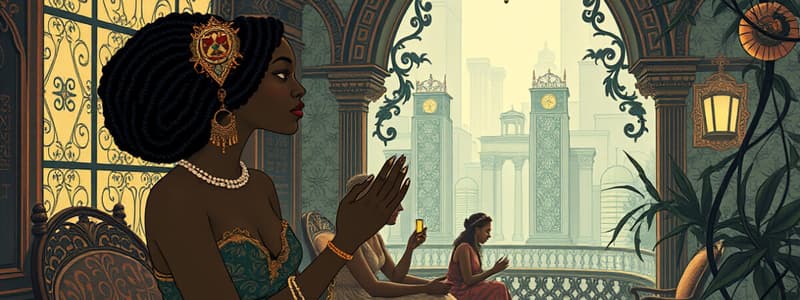Podcast
Questions and Answers
What is the Harlem Renaissance and how did it relate to African-American culture?
What is the Harlem Renaissance and how did it relate to African-American culture?
The Harlem Renaissance was the development of the Harlem neighborhood in New York City as a black cultural Mecca and the early 20th century social and artistic rebirth of African-American culture, influencing literature, music, stage performance, and art.
Who did the Harlem Renaissance benefit?
Who did the Harlem Renaissance benefit?
African Americans
When did the Harlem Renaissance happen?
When did the Harlem Renaissance happen?
1920s
What two major events happened before and after the Harlem Renaissance?
What two major events happened before and after the Harlem Renaissance?
Where is Harlem located?
Where is Harlem located?
Why did African Americans move north, also known as the Great Migration?
Why did African Americans move north, also known as the Great Migration?
What are effects of the Harlem Renaissance?
What are effects of the Harlem Renaissance?
What were struggles still faced in the Harlem Renaissance?
What were struggles still faced in the Harlem Renaissance?
Flashcards are hidden until you start studying
Study Notes
Harlem Renaissance Overview
- The Harlem Renaissance was a cultural, social, and artistic explosion centered in Harlem, New York City during the early 20th century.
- It marked a "golden age" for African-American culture, significantly impacting literature, music, art, and performance.
- Harlem became a hub for talented African-Americans, fostering intellectual and creative growth.
- The period redefined perceptions of African-American culture in the U.S., promoting integration between black and white cultures.
Beneficiaries of the Harlem Renaissance
- The Harlem Renaissance primarily benefited African-Americans, enhancing their cultural identity and pride.
- It initiated a cultural awakening, emphasizing intellect, talent, and artistic expression.
- This era contributed to a decline in racism and segregation, fostering greater cultural integration.
Timeline of the Harlem Renaissance
- The Harlem Renaissance occurred during the 1920s, amidst significant social change in America.
Major Historical Context
- This cultural movement followed the end of World War I and preceded the Great Depression.
- It was influenced by the societal shifts and economic changes occurring during these significant events.
Location of Harlem
- Harlem is a neighborhood located in New York City.
Great Migration
- The Great Migration saw many African Americans move north during the 1920s, seeking jobs lost after soldiers returned from World War I.
- Economic downturns in the South, particularly due to cotton crop failures, also pushed rural Southerners to migrate north.
Effects of the Harlem Renaissance
- It provided the American public with a new perspective on life through African-American experiences.
- Art, music, and literature became vital forms of self-expression for African-Americans during this time.
- The movement also sparked early civil rights advocacy, empowering African-Americans to voice their rights and experiences.
Ongoing Struggles
- Despite its achievements, the Harlem Renaissance faced challenges such as racial segregation and identity crises.
- Violent incidents and riots indicated ongoing racial tensions and struggles within the community, including the complexities of mixed heritage identities.
Studying That Suits You
Use AI to generate personalized quizzes and flashcards to suit your learning preferences.




